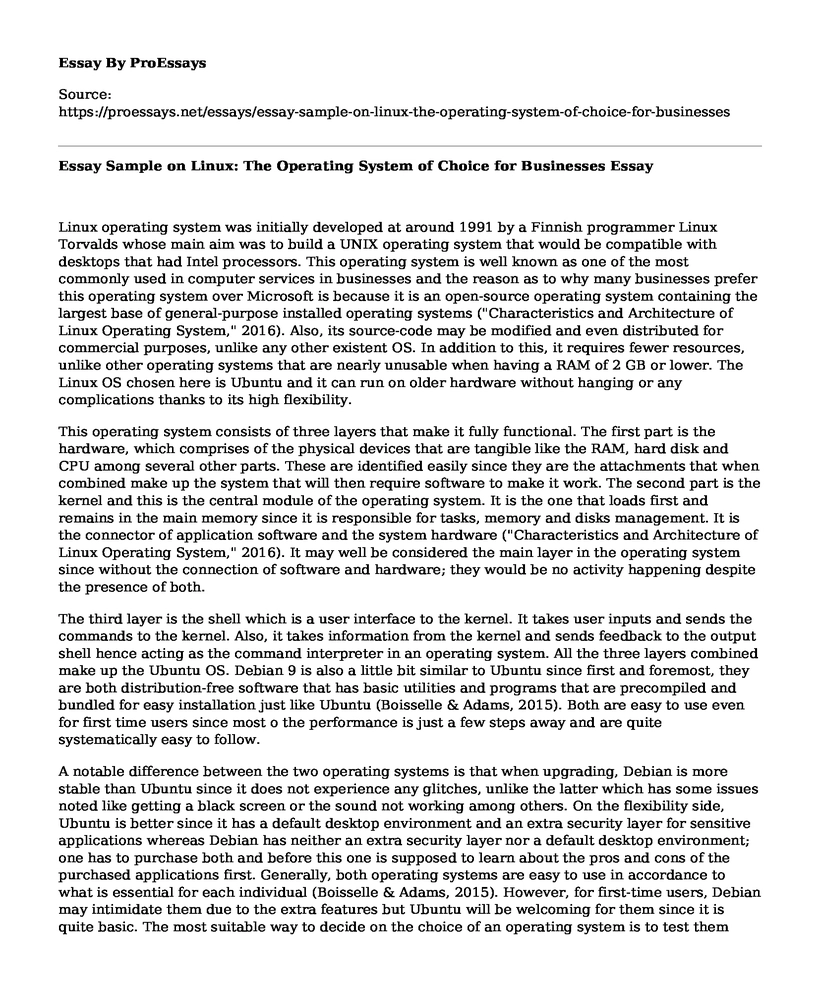Linux operating system was initially developed at around 1991 by a Finnish programmer Linux Torvalds whose main aim was to build a UNIX operating system that would be compatible with desktops that had Intel processors. This operating system is well known as one of the most commonly used in computer services in businesses and the reason as to why many businesses prefer this operating system over Microsoft is because it is an open-source operating system containing the largest base of general-purpose installed operating systems ("Characteristics and Architecture of Linux Operating System," 2016). Also, its source-code may be modified and even distributed for commercial purposes, unlike any other existent OS. In addition to this, it requires fewer resources, unlike other operating systems that are nearly unusable when having a RAM of 2 GB or lower. The Linux OS chosen here is Ubuntu and it can run on older hardware without hanging or any complications thanks to its high flexibility.
This operating system consists of three layers that make it fully functional. The first part is the hardware, which comprises of the physical devices that are tangible like the RAM, hard disk and CPU among several other parts. These are identified easily since they are the attachments that when combined make up the system that will then require software to make it work. The second part is the kernel and this is the central module of the operating system. It is the one that loads first and remains in the main memory since it is responsible for tasks, memory and disks management. It is the connector of application software and the system hardware ("Characteristics and Architecture of Linux Operating System," 2016). It may well be considered the main layer in the operating system since without the connection of software and hardware; they would be no activity happening despite the presence of both.
The third layer is the shell which is a user interface to the kernel. It takes user inputs and sends the commands to the kernel. Also, it takes information from the kernel and sends feedback to the output shell hence acting as the command interpreter in an operating system. All the three layers combined make up the Ubuntu OS. Debian 9 is also a little bit similar to Ubuntu since first and foremost, they are both distribution-free software that has basic utilities and programs that are precompiled and bundled for easy installation just like Ubuntu (Boisselle & Adams, 2015). Both are easy to use even for first time users since most o the performance is just a few steps away and are quite systematically easy to follow.
A notable difference between the two operating systems is that when upgrading, Debian is more stable than Ubuntu since it does not experience any glitches, unlike the latter which has some issues noted like getting a black screen or the sound not working among others. On the flexibility side, Ubuntu is better since it has a default desktop environment and an extra security layer for sensitive applications whereas Debian has neither an extra security layer nor a default desktop environment; one has to purchase both and before this one is supposed to learn about the pros and cons of the purchased applications first. Generally, both operating systems are easy to use in accordance to what is essential for each individual (Boisselle & Adams, 2015). However, for first-time users, Debian may intimidate them due to the extra features but Ubuntu will be welcoming for them since it is quite basic. The most suitable way to decide on the choice of an operating system is to test them both and after having a direct experience with both platforms, an individual can, therefore, decide on the most suitable choice for them.
References
Boisselle, V., & Adams, B. (2015). The impact of cross-distribution bug duplicates, empirical study on Debian and Ubuntu. 2015 IEEE 15th International Working Conference on Source Code Analysis and Manipulation (SCAM). doi:10.1109/scam.2015.7335409
Characteristics and Architecture of Linux Operating System. (2016, January 20). Retrieved from http://www.linux-india.org/characteristics-and-architecture-of-linux-oprating-system/
Cite this page
Essay Sample on Linux: The Operating System of Choice for Businesses. (2023, Feb 11). Retrieved from https://proessays.net/essays/essay-sample-on-linux-the-operating-system-of-choice-for-businesses
If you are the original author of this essay and no longer wish to have it published on the ProEssays website, please click below to request its removal:
- Work-ready Skills: A Personal Action Plan Example
- Globalization and Emergent Strategies Essay
- Biography and Successes of Jeff Bezos Paper Example
- Essay Sample on Pinto's Fires Case
- Essay Sample on Statistics as Essential Tool for Smart Decision-Making in Management
- Paper Example on OSSTMM: Comprehensive Security Testing Methodology Guide
- Research Paper on Nike: Dominant Player in Global Sports Equipment Market







